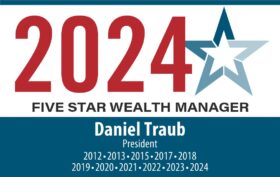October 2019
While the overall trend in the stock market continued up in the third quarter, the rate of increase has been slowing. The S&P 500 was up 1.7% in the third quarter compared to gains in the first and second quarters of 13.6% and 4%, respectively. Still, a gain is a gain!
Beyond the S&P 500, though, returns varied quite a bit. On the positive side utilities and real estate both gained over 6%. On the negative side international stocks (-1%), small-cap stocks (-2.4%), technology (-1.4%) and healthcare (-6.3%) were all down for the quarter.
As interest rates have generally declined in 2019 bonds have continued to offer attractive total returns. In the third quarter short-term bonds were up .78%, intermediate bonds were up 2.3%, and long-term bonds were up 5.3%. Most other categories were up around 1%, with convertible bonds the outlier at a loss of -0.4%.
In the normal course of events there is a symbiotic relationship between a myriad of economic factors: inflation affects interest rates, interest rates affect stock market valuations, employment affects consumer spending, consumer spending affects inflation, and so on. In the long run stock and bond values are dictated by these relationships.
In the short to intermediate term, however, exogenous or temporary factors can mask this process. Think natural disasters, temporary government shutdowns (or the threat of one), elections, oil embargos, global conflicts, etc.
Inflation is a prime example right now. Inflation should be higher. Trump’s policies (trade/tariffs, immigration, infrastructure, increased national debt) are inflationary, the unemployment rate is below what is considered full employment, and we are in the late stages of a recovery. What are we missing? Where is the inflation?
I have two explanations as to why inflation is not higher. The first is relatively straight forward and conventional. Growth around the world is weak and interest rates are at or close to zero in a good portion of the world. The United States cannot be at 4% interest rates, or even 3%, if for no other reason than foreign investors will purchase our bonds for the higher yields, which in turn will drive up prices and drive down interest rates.
The second is my own, less conventional theory. I believe the markets are starting to consider Trump himself to be a temporary event. Whether via impeachment or via the 2020 election people are already starting to look beyond a Trump Presidency. The next President, whether Republican or Democrat, will undoubtedly have less inflationary policies.
If I’m right it would explain why Trump’s tweets are losing their ability to move the markets.
Tempo Financial Advisors’ 3rd Quarter Investment Performance
Tempo Dynamic Income continues to be our star performer in 2019. Our return of just under 5% for the quarter was the second-best quarterly return for Dynamic Income since we opened our doors in 2008. It is also between 3% and 4% better than benchmarks.
Year-to-date Dynamic Income has returned 14.3% which would be our best calendar year return if the year were to end here. It is also between 6% and 10% better than benchmarks. Just what we needed coming off 2018, which, as you may recall, was a tough year for Dynamic Income.
Accounts have been rebalanced for the fourth quarter. We are still overweight in long-term bonds, though intermediate-term and global bonds have been replaced by real estate and managed futures.
Tempo Dynamic Growth also had a successful quarter with a positive return that beat its benchmark. Our return of 0.9% was a fraction better than our benchmark, even though we are at our minimum equity exposure (40%). Unfortunately we trail the benchmark year-to-date by about 1.5%. Still time!
Dynamic Growth accounts have been rebalanced for the fourth quarter and we continue to be at our minimum allowed equity allocation. Emerging market stocks and intermediate-term corporate bonds have been replaced by real estate, managed futures, financial stocks, and inflation bonds.
Dynamic Growth and Dynamic Income have a fair amount of overlap among investments at the moment. But the holdings are sending very different messages. Dynamic Income is predominantly invested in long-term bonds, utilities and real estate. In Dynamic Income’s world these are aggressive. I consider real estate and utilities in Dynamic Growth to be conservative. It is all a matter of perspective.
Tempo Lifestyle accounts returned between 0.5% and 1% in the third quarter. Interestingly the benchmark return was 0.75% regardless of risk level (conservative, moderate, aggressive). That means that some Tempo clients were slightly below the benchmark, some were equal to the benchmark, and some were slightly ahead.
Year-to date Lifestyle trails it’s benchmarks by between 1% and 2% depending on whether conservative or aggressive. Usually I hate to underperform. Not this time. Why?
I can trace the underperformance to two factors. First we own both mid-cap and small-cap stocks, both of which underperformed large caps. Second is that the duration (i.e. interest rate sensitivity) of our bond holdings is relatively short, which means we did not capture as much of the upside in bonds as we might have otherwise.
But here is the thing: owning mid-cap and small-cap stocks is the right thing to do for diversification purposes. There are times when small and mid will outperform large. And with interest rates where they are, I’d rather forgo some of the return in bonds should interest rates continue to fall in favor of positioning us for steady returns in case interest rates stay flat or for mitigated losses in case interest rates rise. Regrets, I’ve had a few 1 … but these aren’t among them!
Reminder
Please contact us if there has been a change in your financial circumstances that would warrant a fresh perspective on your portfolio.
Daniel J. Traub
1. My Way, Frank Sinatra, 1969
Return to Tempo Vantage Newsletters

